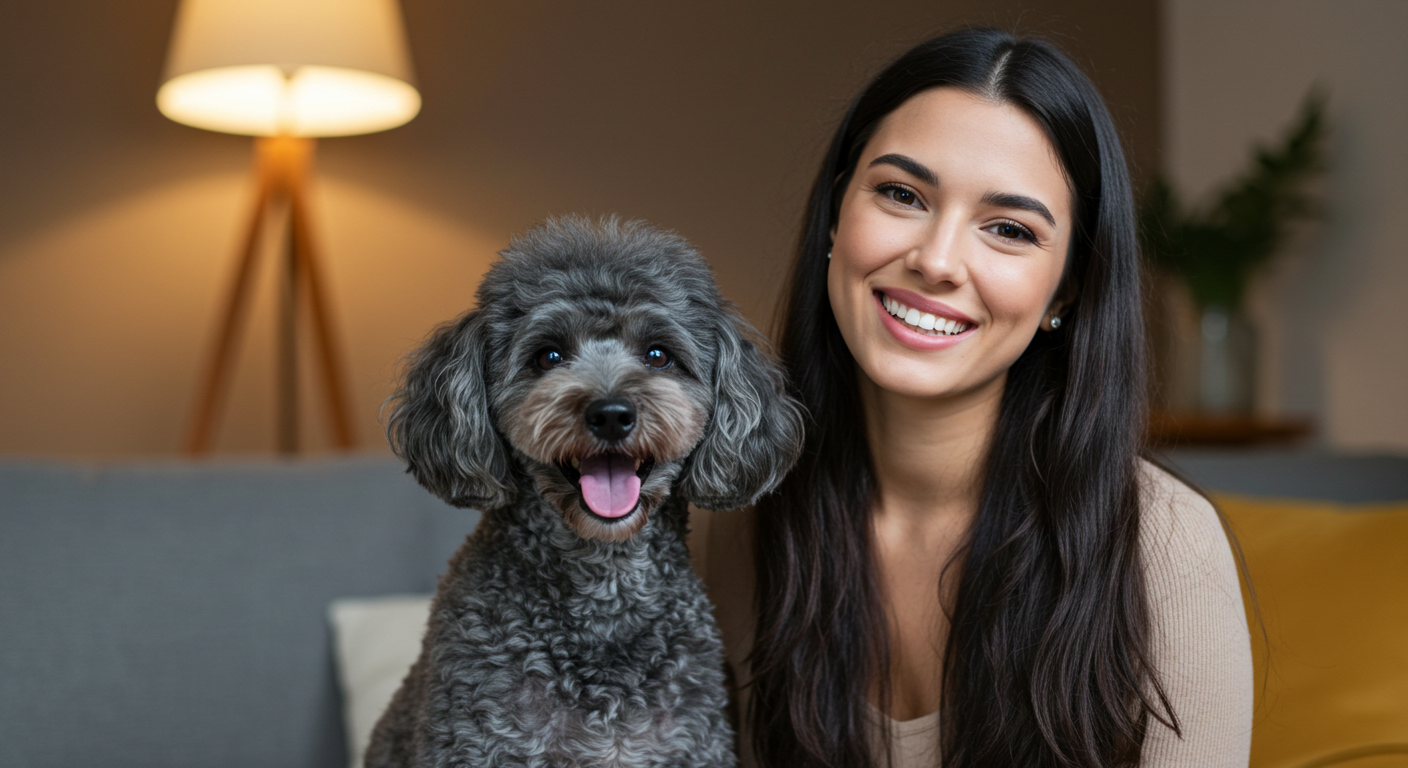If you’ve ever fallen in love with a furry companion only to find yourself sneezing, wheezing, or dealing with itchy eyes, you’re not alone. Pet allergies affect up to 15% of the population, but that doesn’t mean you have to give up your dream of dog ownership. Hypoallergenic dogs offer hope for allergy sufferers who want the joy of a canine companion without the discomfort of allergic reactions.
This comprehensive guide explores everything you need to know about hypoallergenic dog breeds, from understanding what makes them special to finding the perfect match for your lifestyle and allergy sensitivity. We’ll dive deep into breed characteristics, care requirements, and practical advice for living successfully with a hypoallergenic dog.
Table of Contents
- Hypoallergenic Dogs Meaning: What Makes a Dog Hypoallergenic?
- Hypoallergenic Dogs Large: Big Breeds for Allergy Sufferers
- Hypoallergenic Dogs Small: Compact Companions
- Non-Shedding/Hypoallergenic Dogs: Understanding the Connection
- Hypoallergenic Dogs Food: Nutrition for Sensitive Breeds
- Hypoallergenic Dogs for Adoption: Finding Your Perfect Match
- Living Successfully with Hypoallergenic Dogs
- Grooming and Maintenance Requirements
- Training and Socialization
- Health Considerations for Hypoallergenic Breeds
- Cost Analysis: Budgeting for a Hypoallergenic Dog
- Frequently Asked Questions
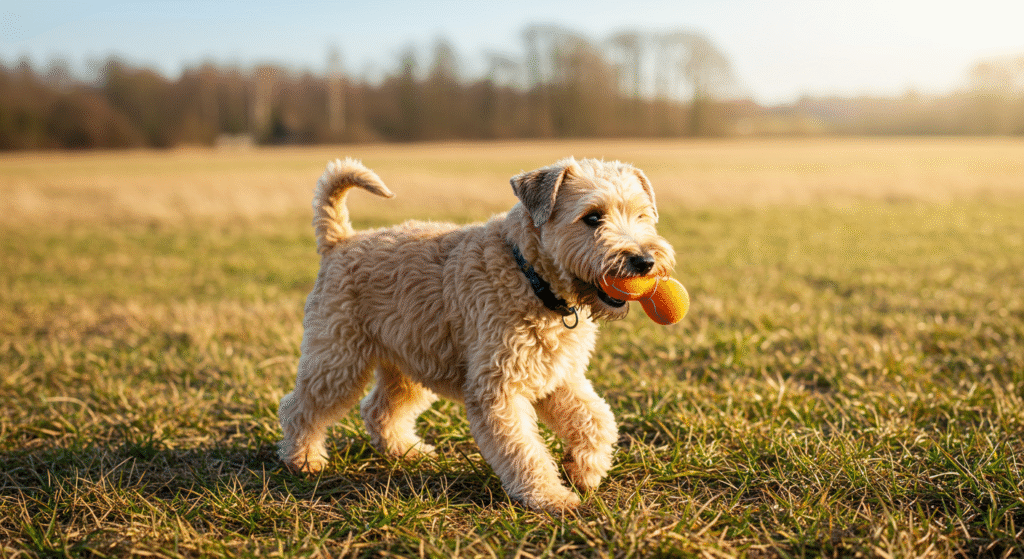
Hypoallergenic Dogs Meaning: What Makes a Dog Hypoallergenic? {#hypoallergenic-dogs-meaning}
The term “hypoallergenic” literally means “below allergenic” or less likely to cause allergic reactions. When we talk about hypoallergenic dogs, we’re referring to breeds that produce fewer allergens than typical dogs. These allergens aren’t actually found in dog hair, as many people believe, but in proteins present in their saliva, urine, and dander (dead skin cells).
The primary culprit behind dog allergies is a protein called Can f 1, which dogs secrete through their skin and spread when they groom themselves. Some breeds naturally produce lower levels of these allergenic proteins, while others have coat types that trap allergens rather than allowing them to become airborne. The misconception that dog hair itself causes allergies has led many people to focus solely on shedding, but the reality is more complex.
Hypoallergenic dogs typically share certain characteristics: they often have curly or wiry coats that trap dander instead of releasing it into the air, they shed minimally, and some breeds naturally produce fewer allergenic proteins. However, it’s crucial to understand that no dog is 100% hypoallergenic. Individual dogs within the same breed can vary in their allergen production, and people’s sensitivities differ greatly.
The science behind hypoallergenic breeds continues to evolve. Recent studies have shown that factors like a dog’s size, age, and even gender can influence allergen levels. Male dogs typically produce more Can f 1 protein than females, and intact dogs often produce more allergens than spayed or neutered animals. Understanding these nuances helps potential dog owners make informed decisions about which breeds might work best for their specific allergies.
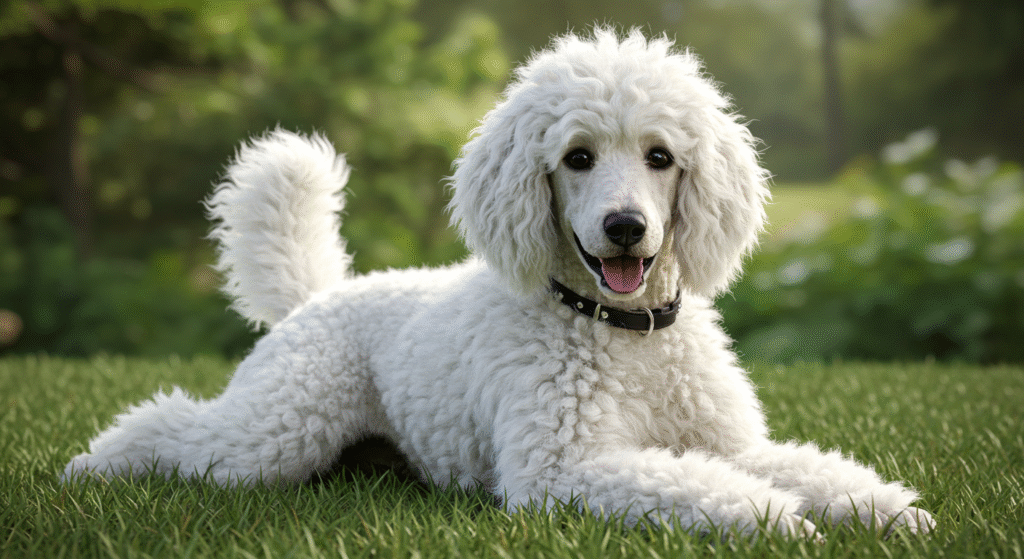
Hypoallergenic Dogs Large: Big Breeds for Allergy Sufferers {#hypoallergenic-dogs-large}
Large hypoallergenic dogs offer the perfect combination of size and allergy-friendly qualities for families who want a substantial canine companion. These breeds prove that you don’t have to compromise on size to accommodate allergies, providing the same loyalty, protection, and presence that larger dogs are known for.
The Standard Poodle stands as the gold standard among large hypoallergenic breeds. These intelligent, athletic dogs weigh between 45-70 pounds and possess the classic Poodle coat that traps allergens effectively. Their curly, dense fur requires regular professional grooming every 6-8 weeks, but their minimal shedding and low allergen production make them excellent choices for allergy sufferers. Standard Poodles excel in various activities from agility to therapy work, making them versatile family companions.
Portuguese Water Dogs gained fame as the Obama family’s choice during their White House years, and for good reason. These medium-to-large dogs (35-60 pounds) were originally bred to work alongside fishermen, giving them a robust, athletic build and webbed feet. Their wavy or curly coat comes in black, brown, or white, and requires regular maintenance to prevent matting. Their high energy levels make them perfect for active families who enjoy outdoor activities.
The Giant Schnauzer represents the largest of the Schnauzer family, weighing 55-85 pounds. These powerful, intelligent dogs have a distinctive double coat consisting of a soft undercoat and a wiry outer coat. Their facial hair gives them a distinguished appearance, but more importantly, their coat type minimizes allergen distribution. Giant Schnauzers require firm, consistent training due to their size and strong-willed nature, but they reward dedicated owners with unwavering loyalty.
Airedales, known as the “King of Terriers,” are the largest terrier breed at 50-70 pounds. Their wiry, dense coat requires hand-stripping or professional grooming to maintain its texture and hypoallergenic properties. Airedales are known for their intelligence, courage, and versatility – they’ve served as war dogs, hunters, and family guardians throughout history. Their independent nature requires patient, consistent training, but their loyalty and protective instincts make them excellent family dogs.
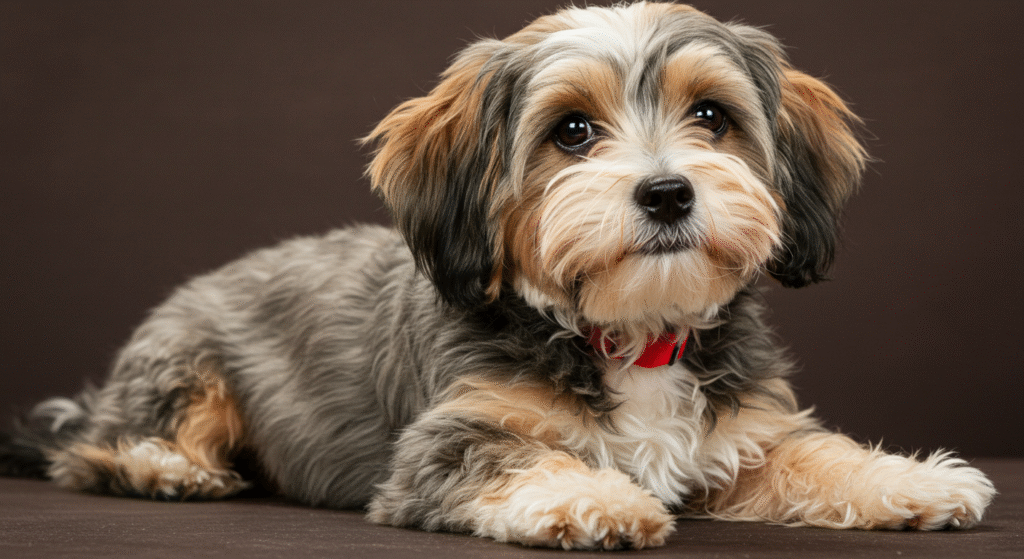
Hypoallergenic Dogs Small: Compact Companions {#hypoallergenic-dogs-small}
Small hypoallergenic dogs pack tremendous personality into compact packages, making them ideal for apartments, seniors, or families who prefer more manageable pets. These breeds offer all the benefits of hypoallergenic qualities while requiring less space and often adapting well to various living situations.
The Maltese represents one of the most ancient toy breeds, weighing just 4-7 pounds with a gorgeous silky white coat that flows like silk. Despite their delicate appearance, Maltese dogs are surprisingly hardy and can live 12-15 years with proper care. Their single-layer coat doesn’t shed traditionally but requires daily brushing to prevent matting and tangles. These dogs form incredibly strong bonds with their owners and often prefer to be lap dogs rather than independent players.
Yorkshire Terriers or “Yorkies” typically weigh 4-7 pounds but possess the confidence of much larger dogs. Their steel-blue and tan coat is actually hair rather than fur, growing continuously and requiring regular trimming. Many Yorkie owners keep their dogs in “puppy cuts” for easier maintenance while still maintaining the hypoallergenic benefits. Despite their small size, Yorkies retain strong terrier instincts and can be excellent watchdogs, alerting their families to any unusual activity.
Havanese dogs, Cuba’s national breed, weigh 7-13 pounds and sport a double coat that can be wavy or curly. Their coat comes in various colors and patterns, from pure white to black and everything in between. Havanese are known for their social nature and adaptability – they’re equally happy in apartments or houses and get along well with children and other pets. Their intelligence makes them excellent candidates for therapy work and dog sports.
The Chinese Crested comes in two varieties: hairless and powder puff. The hairless variety has smooth, warm skin with hair only on the head, feet, and tail, making them virtually allergen-free. The powder puff variety has a full, silky double coat. Both types typically weigh 5-12 pounds and are known for their affectionate, alert nature. Chinese Crested dogs require sun protection and warm clothing in cold weather but adapt well to various climates with proper care.
Coton de Tulear dogs, weighing 8-15 pounds, have cotton-like coats that give them their name. These Madagascar natives are known for their clown-like personalities and strong desire to please their owners. Their hypoallergenic coat requires regular brushing but doesn’t shed in the traditional sense, instead forming small mats that can be easily removed with proper grooming techniques.
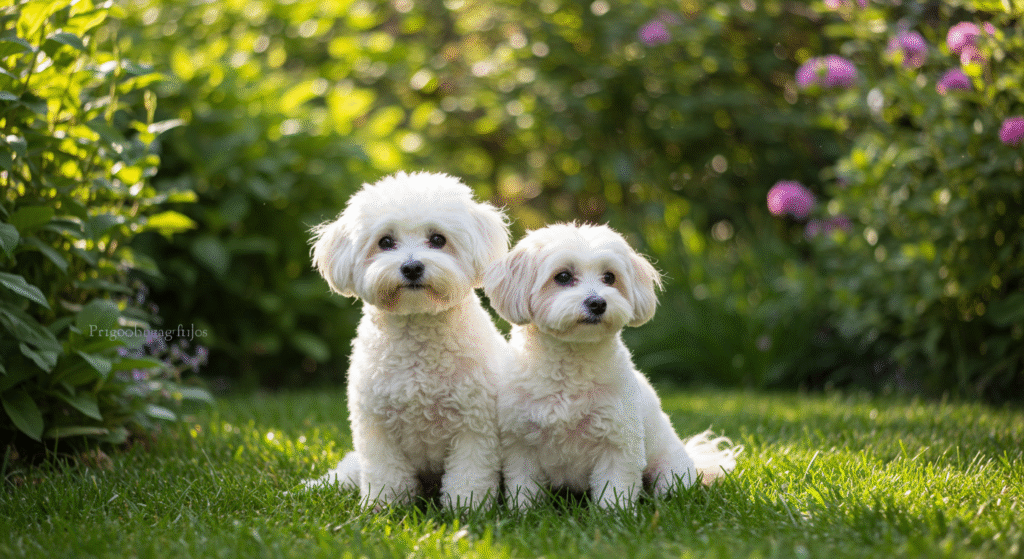
Non-Shedding/Hypoallergenic Dogs: Understanding the Connection {#non-shedding-hypoallergenic-dogs}
The relationship between shedding and hypoallergenic qualities is often misunderstood, but it’s crucial for allergy sufferers to grasp this connection. While non-shedding and hypoallergenic aren’t identical terms, they’re closely related in ways that significantly impact allergen levels in your home environment.
Traditional shedding involves dogs losing their outer guard hairs and undercoat in seasonal cycles or continuously throughout the year. When dogs shed, they release not just hair but also the dander (dead skin cells) attached to that hair, along with dried saliva from grooming. This creates airborne particles that trigger allergic reactions in sensitive individuals. Non-shedding dogs, by contrast, have hair that grows continuously like human hair and falls out individually rather than in clumps.
Poodles and Poodle mixes exemplify the non-shedding category perfectly. Their curly coats trap loose hair and dander rather than releasing it into the environment. This means allergens stay contained within the coat until removed through brushing or professional grooming. However, this also means that regular grooming becomes essential – neglected Poodle coats can become matted repositories of allergens.
Bichon Frises have similar coat characteristics, with their cotton-ball appearance resulting from hair that grows continuously and curls back on itself. Their undercoat catches loose hairs and dander, preventing them from becoming airborne. Professional grooming every 4-6 weeks helps maintain their hypoallergenic properties by removing trapped allergens and preventing matting.
It’s important to note that “non-shedding” is somewhat of a misnomer – all dogs lose some hair. The difference lies in how and when this hair loss occurs. Non-shedding breeds lose hair gradually and in small amounts, often during brushing or bathing, rather than leaving hair all over furniture and carpets. This controlled hair loss significantly reduces the amount of allergens circulating in your home.
The texture of non-shedding coats also plays a role in their hypoallergenic properties. Curly and wiry coats create more surface area that traps particles, while straight, smooth coats allow allergens to escape more easily. This is why breeds like Portuguese Water Dogs and Kerry Blue Terriers are often well-tolerated by people with allergies, despite being larger dogs.
Understanding this connection helps explain why regular grooming is non-negotiable for hypoallergenic breeds. Professional grooming not only maintains the coat’s appearance but actively removes trapped allergens from your dog’s hair, preventing them from eventually becoming airborne in your home. Between professional sessions, daily brushing serves the same purpose on a smaller scale.
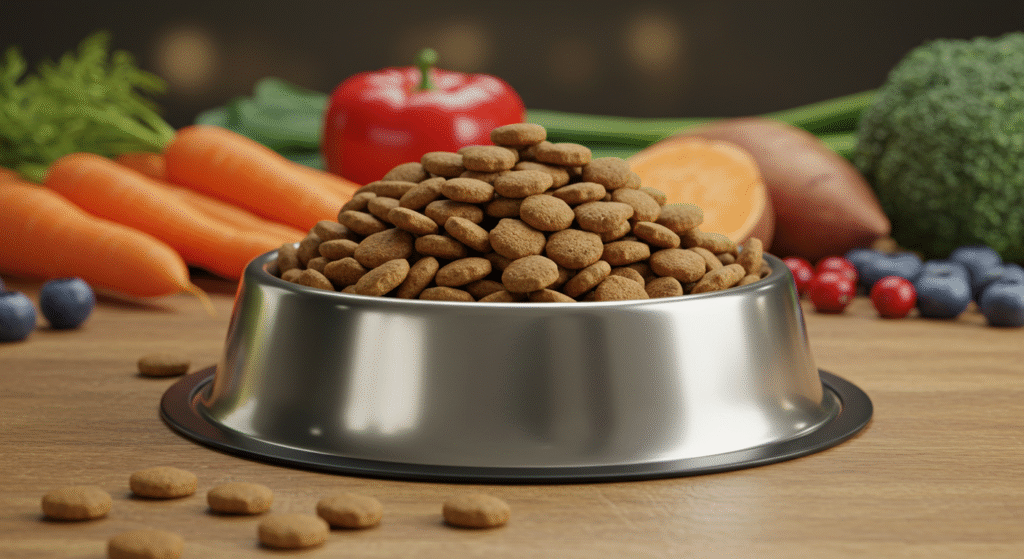
Hypoallergenic Dogs Food: Nutrition for Sensitive Breeds {#hypoallergenic-dogs-food}
Proper nutrition plays a crucial role in maintaining the hypoallergenic qualities of these special breeds while supporting their overall health and coat condition. Many hypoallergenic dogs have sensitive digestive systems that require carefully selected ingredients to prevent both food allergies and skin issues that could increase dander production.
Protein quality forms the foundation of good nutrition for hypoallergenic breeds. High-quality, easily digestible proteins like deboned chicken, fish, lamb, or novel proteins such as venison or duck provide essential amino acids for healthy skin and coat. Many hypoallergenic dogs thrive on limited ingredient diets that reduce the risk of food sensitivities while providing concentrated nutrition. Avoid foods with excessive protein sources, as this can increase the likelihood of developing food allergies over time.
Omega fatty acids deserve special attention in hypoallergenic dog nutrition. Omega-3 and omega-6 fatty acids support skin health, reduce inflammation, and promote a lustrous coat that better traps allergens. Fish oil, flaxseed oil, and chicken fat are excellent sources of these essential nutrients. Dogs with healthy skin produce less dander, which directly impacts their hypoallergenic properties. Supplementing with fish oil can be particularly beneficial for breeds prone to skin sensitivities.
Grain-free versus grain-inclusive diets present an ongoing debate in canine nutrition. While some hypoallergenic dogs benefit from grain-free formulations, others do well with whole grains like brown rice or oats. The key is identifying your individual dog’s sensitivities through careful observation or elimination diets. Common food allergens in dogs include beef, dairy, wheat, chicken, and soy, but any ingredient can potentially cause reactions in sensitive individuals.
Digestive health significantly impacts skin and coat condition in hypoallergenic breeds. Probiotics and prebiotics support healthy gut bacteria, which influences immune function and skin health. Many premium dog foods now include these beneficial additions, but they can also be supplemented separately. Dogs with healthy digestive systems typically have better skin condition and produce less dander.
Hydration and moisture content in food can affect skin health. Wet foods or adding water to dry kibble increases overall moisture intake, supporting skin hydration from the inside out. Dehydrated skin produces more dander, potentially reducing the hypoallergenic benefits of your chosen breed. Consider rotating between wet and dry foods or adding bone broth to increase palatability and moisture content.
Special considerations for puppy nutrition in hypoallergenic breeds focus on supporting proper coat development and immune system maturation. Puppy formulations typically contain higher protein and fat levels to support growth, but they should still prioritize digestible ingredients and avoid common allergens. Early nutrition sets the foundation for lifelong coat quality and overall health.
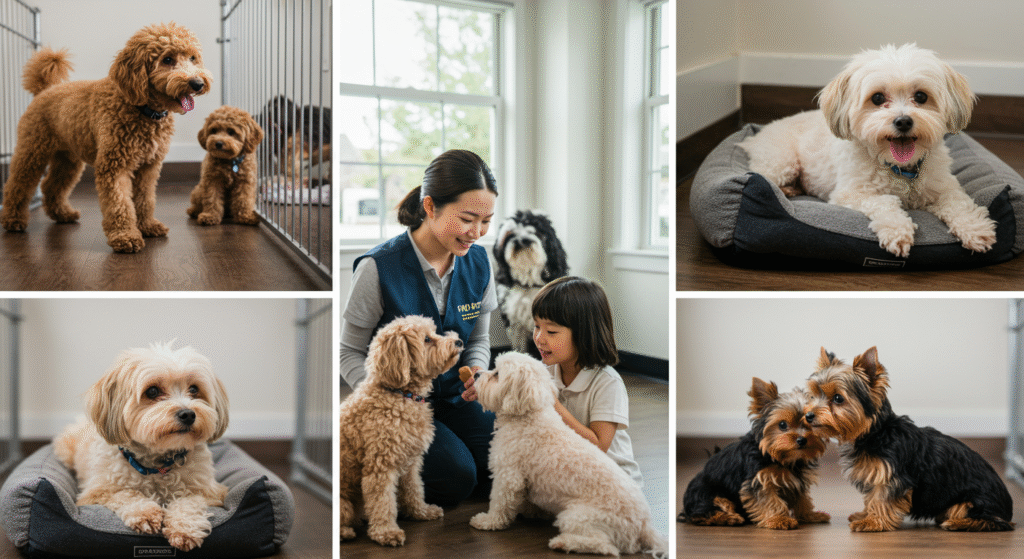
Hypoallergenic Dogs for Adoption: Finding Your Perfect Match {#hypoallergenic-dogs-for-adoption}
Adopting a hypoallergenic dog presents unique opportunities and challenges that require careful consideration and preparation. While purebred hypoallergenic puppies can cost thousands of dollars, adoption offers a chance to provide a loving home for a dog in need while potentially saving money and gaining a grateful, mature companion.
Breed-specific rescues represent your best opportunity to find purebred hypoallergenic dogs for adoption. Organizations dedicated to Poodles, Bichon Frises, Portuguese Water Dogs, and other hypoallergenic breeds often have detailed knowledge about each dog’s history, temperament, and care requirements. These rescues typically perform thorough health checks, behavioral assessments, and can provide valuable insights about how well a particular dog might work for allergy sufferers.
Mixed breed considerations require extra attention when seeking hypoallergenic qualities. Poodle mixes, often called “designer dogs,” have become increasingly popular in shelters, but their hypoallergenic properties can vary significantly. A dog that’s half Poodle and half Golden Retriever may inherit more of the Golden’s shedding coat than the Poodle’s hypoallergenic qualities. Meet potential adoptees multiple times and spend extended periods with them to assess your allergic reactions before committing.
Age advantages in adoption often work in favor of allergy sufferers. Adult and senior dogs have fully developed coats, allowing you to accurately assess their shedding patterns and allergen production. Puppies may have different coat textures that change as they mature, making their adult hypoallergenic qualities unpredictable. Additionally, older dogs often come housetrained and past the destructive puppy phase, making them easier to integrate into allergy-sensitive households.
Foster-to-adopt programs provide excellent opportunities to test compatibility before making a permanent commitment. Many rescues offer trial periods or foster programs that allow you to evaluate how well you tolerate a particular dog’s allergen levels in your home environment. This approach removes the pressure of immediate decision-making while giving both you and the dog time to adjust.
Preparation for adoption should include allergy testing with your doctor to identify your specific sensitivities and potentially starting allergy medications before bringing your new companion home. Create an allergen-controlled environment with HEPA air purifiers, hypoallergenic bedding, and establish grooming routines that will minimize allergen exposure from day one.
Research local shelters and rescue organizations that specifically work with hypoallergenic breeds or maintain detailed records about their animals’ coat types and shedding patterns. Many shelters now include this information in their online profiles, making it easier to identify potentially suitable matches before visiting. Don’t overlook senior dog rescues, as older hypoallergenic dogs often make wonderful companions for people seeking calmer, well-trained pets.
Adoption fees and ongoing costs for hypoallergenic breeds typically reflect their popularity and grooming requirements. While adoption fees are generally lower than purchasing from breeders, ongoing grooming costs remain substantial. Budget for professional grooming every 6-8 weeks, high-quality food, and potential allergy-related expenses like air purifiers and specialized cleaning products.
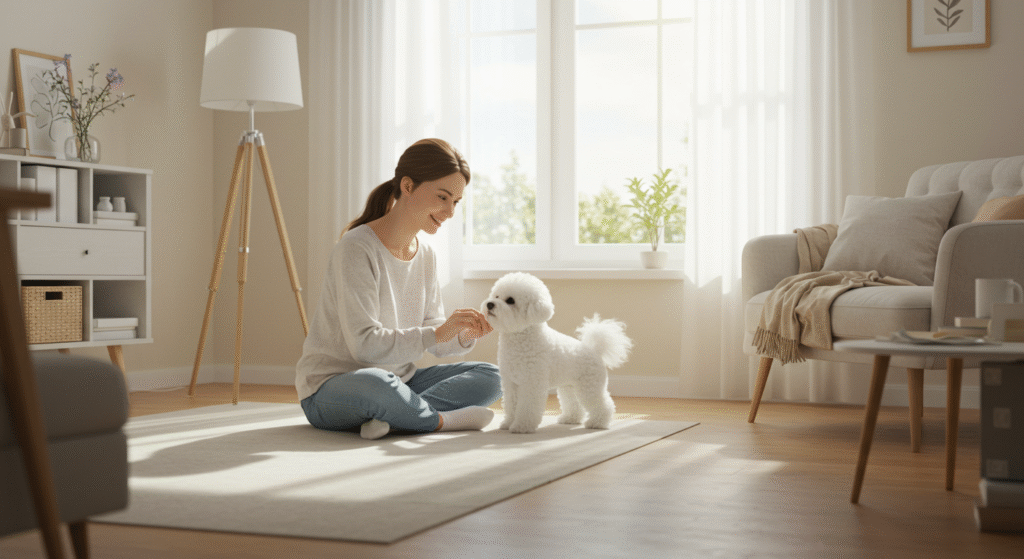
Living Successfully with Hypoallergenic Dogs
Successfully integrating a hypoallergenic dog into an allergy-sensitive household requires more than simply choosing the right breed. Creating an environment that maximizes your dog’s hypoallergenic benefits while minimizing allergen exposure involves strategic planning, consistent maintenance routines, and understanding how to work with your dog’s natural characteristics.
Environmental controls form the foundation of successful coexistence with hypoallergenic breeds. HEPA air purifiers should run continuously in main living areas and bedrooms, with filters changed according to manufacturer recommendations. These devices remove airborne particles including dander, pollen, and other allergens that could exacerbate sensitivities. Consider multiple smaller units rather than one large purifier to ensure adequate coverage throughout your home.
Flooring choices significantly impact allergen management. Hard surfaces like hardwood, tile, or vinyl are preferable to carpeting, which traps and holds allergens even with regular vacuuming. If carpeting is unavoidable, choose low-pile options and invest in a high-quality vacuum with HEPA filtration. Steam cleaning carpets monthly helps remove embedded allergens that regular vacuuming misses.
Bedroom sanctuaries should remain dog-free zones to ensure allergy sufferers have a retreat space with minimal allergen exposure. This doesn’t mean banishing your beloved pet – it simply provides a clean environment for restorative sleep. Use allergen-proof mattress and pillow covers, wash bedding weekly in hot water, and maintain dedicated air purification in sleeping areas.
Bathing schedules for hypoallergenic dogs should be more frequent than traditional breeds, typically every 2-3 weeks rather than monthly. Use gentle, hypoallergenic shampoos that won’t dry out the skin and potentially increase dander production. Some allergy sufferers find that weekly baths significantly reduce their symptoms, though over-bathing can cause skin irritation and paradoxically increase allergen production.
Clothing and fabric management requires attention in households with allergy-sensitive members. Washable throw blankets on furniture where your dog rests can be laundered frequently to remove accumulated allergens. Keep a designated set of “dog clothes” for grooming and outdoor activities, washing them separately from regular laundry. Consider allergen-reducing laundry additives that help break down protein-based allergens.
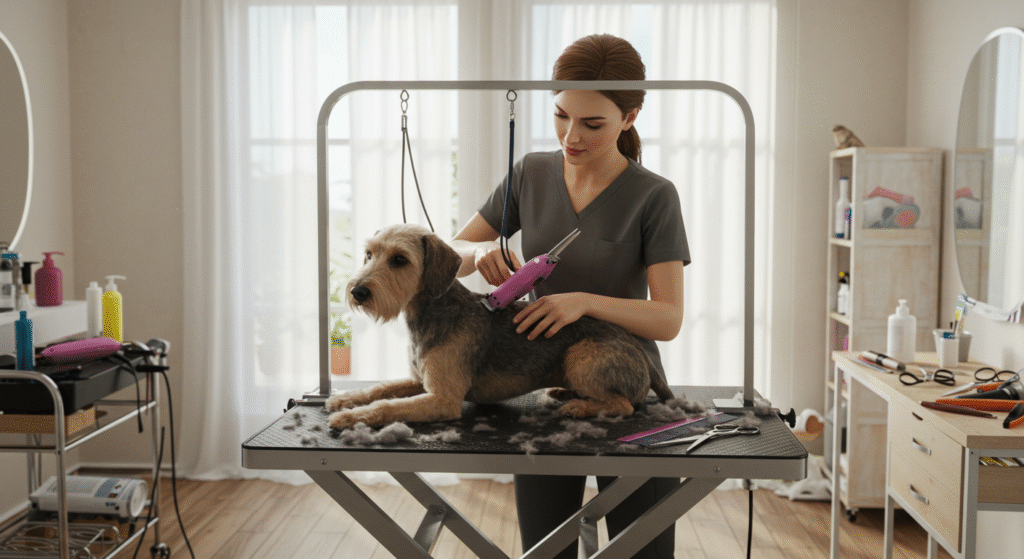
Grooming and Maintenance Requirements
Professional grooming represents a non-negotiable investment for hypoallergenic dog owners, serving both aesthetic and health purposes while directly impacting allergen management. Understanding proper grooming techniques and schedules helps maintain your dog’s hypoallergenic properties while ensuring their comfort and well-being.
Professional grooming frequency varies by breed but generally ranges from every 4-8 weeks. Poodles and Poodle mixes require grooming every 6-8 weeks to prevent matting and maintain their coat’s allergen-trapping abilities. Bichon Frises need attention every 4-6 weeks due to their fast-growing, cotton-like coats. Delaying professional grooming can result in matted coats that become allergen repositories and may require complete shaving to resolve.
Between-visit maintenance becomes crucial for preserving hypoallergenic benefits. Daily brushing removes loose hair and trapped allergens before they can become airborne or cause matting. Use appropriate tools – slicker brushes work well for most curly coats, while pin brushes suit silkier textures. Establish brushing as a positive routine through treats and praise, making it an enjoyable bonding activity rather than a stressful chore.
Bathing techniques require special consideration for hypoallergenic breeds. Use lukewarm water and hypoallergenic shampoos specifically formulated for sensitive skin. Thoroughly rinse all soap residue, as remaining products can cause skin irritation and increase dander production. Some owners find that adding a final rinse with diluted apple cider vinegar helps remove soap residue and adds shine to the coat.
Nail trimming and ear cleaning form essential components of hypoallergenic dog care. Long nails can cause scratching that irritates skin and increases dander production. Many hypoallergenic breeds have hair that grows inside their ears, requiring regular plucking or trimming to prevent infections that could affect overall health and comfort.
Home grooming tools should include high-quality brushes appropriate for your dog’s coat type, nail clippers, ear cleaning solution, and a good-quality blow dryer for thorough drying after baths. Wet coats can develop mildew or bacterial growth, particularly in breeds with dense undercoats. Professional-grade grooming tools last longer and perform better than pet store alternatives, making them worthwhile investments.
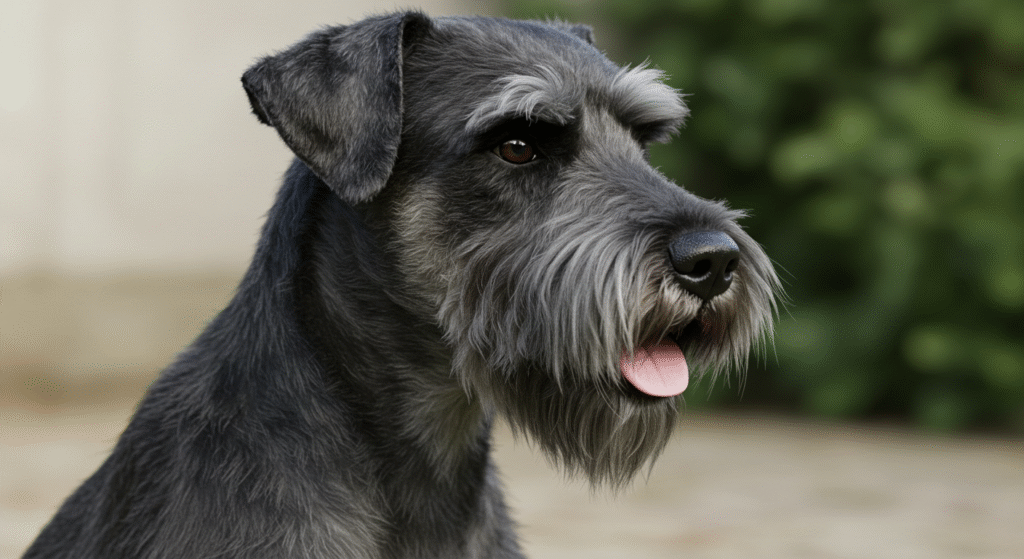
Cost Analysis: Budgeting for a Hypoallergenic Dog
Understanding the true cost of hypoallergenic dog ownership extends far beyond the initial purchase or adoption fee. These breeds require ongoing investments in grooming, high-quality food, and specialized care that can significantly impact your budget. Proper financial planning ensures you can provide optimal care throughout your dog’s lifetime.
Initial costs include the purchase price or adoption fee, which can range from $200-500 for adoption to $1,000-3,000+ for purebred puppies from reputable breeders. Factor in immediate expenses like high-quality food, grooming supplies, bedding, toys, and initial veterinary care including vaccinations, microchipping, and spay/neuter procedures. Budget $500-1,000 for these initial setup costs.
Monthly grooming expenses represent the most significant ongoing cost difference between hypoallergenic and traditional breeds. Professional grooming every 6-8 weeks costs $50-150 depending on your location, dog size, and specific services required. Annual grooming costs can easily reach $400-1,000, making this the largest variable expense in hypoallergenic dog ownership.
Premium food costs reflect the dietary needs of many hypoallergenic breeds. High-quality, limited ingredient, or prescription diets cost $60-120 per month for most dogs, compared to $30-60 for standard foods. While this represents a significant expense, proper nutrition supports skin health and coat condition, potentially reducing veterinary costs and enhancing hypoallergenic properties.
Healthcare considerations for hypoallergenic breeds include routine care plus breed-specific concerns. Many of these breeds live 12-16 years, requiring consistent veterinary care throughout their extended lifespans. Budget $500-1,500 annually for routine care, with additional reserves for emergency situations or age-related health issues.
Environmental management costs include air purifiers, specialized vacuum cleaners, allergen-proof bedding, and cleaning products. Initial setup costs $300-800, with ongoing filter replacements and product replenishment adding $200-400 annually. These expenses directly support successful coexistence between allergy sufferers and their canine companions.
Frequently Asked Questions {#faqs}
What is the most hypoallergenic dog?
No single breed can claim to be the “most” hypoallergenic, as individual dogs vary in allergen production and people have different sensitivity levels. However, Standard Poodles are often considered among the best choices due to their minimal shedding, low dander production, and predictable coat characteristics. Bichon Frises, Portuguese Water Dogs, and Maltese also rank highly for their hypoallergenic qualities. The best choice depends on your specific allergies, lifestyle, and size preferences.
What makes an animal hypoallergenic?
Animals are considered hypoallergenic when they produce fewer allergenic proteins or have physical characteristics that prevent allergen distribution. In dogs, the primary allergen is the Can f 1 protein found in saliva, urine, and dander. Hypoallergenic dogs either produce less of this protein or have coat types that trap allergens rather than releasing them into the air. Factors like coat texture, shedding patterns, and individual genetics all contribute to a dog’s hypoallergenic properties.
Is any dog 100% hypoallergenic?
No dog is completely 100% hypoallergenic. All dogs produce some level of allergenic proteins, though amounts vary significantly between breeds and individuals. Even hairless breeds like the Chinese Crested produce allergens through their saliva and skin. The term “hypoallergenic” means “less allergenic” rather than “non-allergenic.” People with severe allergies may still react to supposedly hypoallergenic breeds, which is why spending time with individual dogs before adoption or purchase is crucial.
Can I get a dog if I’m allergic?
Many people with dog allergies can successfully own hypoallergenic breeds with proper management. Start by consulting an allergist to identify your specific triggers and sensitivity levels. Spend extended time with dogs you’re considering to test your reactions. Implement environmental controls like air purifiers, frequent cleaning, and grooming schedules. Some people benefit from allergy medications or immunotherapy. Success depends on your individual sensitivity, chosen breed, and commitment to allergen management strategies.
What’s the rarest allergy?
The rarest allergies include conditions like aquagenic urticaria (water allergy), affecting fewer than 100 documented cases worldwide. In the context of pets, allergies to specific proteins like Can f 2 or Can f 4 are less common than reactions to Can f 1. Some people are allergic to male dogs but not females, or react to certain colors within the same breed. These unusual presentations highlight why individual testing and exposure are more reliable than breed generalizations for allergy sufferers.
Is a Golden Retriever hypoallergenic?
Golden Retrievers are not hypoallergenic. They have double coats that shed heavily year-round, with seasonal “blowouts” that release massive amounts of hair and dander. They produce normal levels of allergenic proteins and their shedding patterns make them poor choices for allergy sufferers. However, Golden Retriever-Poodle mixes (Goldendoodles) may have more hypoallergenic qualities, though this varies significantly depending on which parent’s coat characteristics they inherit.
Is Shih Tzu hypoallergenic?
Shih Tzus are considered moderately hypoallergenic due to their minimal shedding and hair-like coat texture. Their double coat grows continuously rather than shedding seasonally, which helps contain allergens. However, they do produce normal levels of allergenic proteins, so they’re not suitable for people with severe allergies. Regular grooming is essential to maintain their hypoallergenic benefits, as matted coats can trap and concentrate allergens. Individual Shih Tzus may vary in their allergen production, making personal testing important.
Hypoallergenic Dog Breed Comparison Table
| Breed | Size | Weight Range | Grooming Frequency | Allergen Level | Exercise Needs | Best For |
|---|---|---|---|---|---|---|
| Standard Poodle | Large | 45-70 lbs | 6-8 weeks | Very Low | High | Active families, first-time owners |
| Bichon Frise | Small | 12-18 lbs | 4-6 weeks | Very Low | Moderate | Apartments, seniors, families |
| Portuguese Water Dog | Medium-Large | 35-60 lbs | 6-8 weeks | Low | High | Active families, water activities |
| Maltese | Toy | 4-7 lbs | 4-6 weeks | Low | Low | Apartments, seniors, lap dog lovers |
| Yorkshire Terrier | Toy | 4-7 lbs | 6-8 weeks | Low | Moderate | Apartments, singles, small spaces |
| Havanese | Small | 7-13 lbs | 6-8 weeks | Low | Moderate | Families, therapy work, apartments |
| Chinese Crested | Small | 5-12 lbs | 4-6 weeks | Very Low | Low | Warm climates, unique appearance |
| Giant Schnauzer | Large | 55-85 lbs | 6-8 weeks | Low | High | Experienced owners, guard dogs |
| Airedale Terrier | Large | 50-70 lbs | 6-8 weeks | Low | High | Active families, experienced owners |
| Coton de Tulear | Small | 8-15 pounds | 6-8 weeks | Low | Moderate | Families, companion dogs |
Choosing a hypoallergenic dog represents a significant commitment that extends far beyond the initial decision. These remarkable breeds offer hope for allergy sufferers who refuse to give up their dreams of canine companionship, but success requires understanding, preparation, and ongoing dedication to proper care.
The investment in a hypoallergenic dog – both financial and emotional – pays dividends in the form of a loving companion who can share your life without compromising your health. By understanding the science behind hypoallergenic qualities, implementing proper care routines, and creating allergen-controlled environments, you can enjoy all the benefits of dog ownership while managing your allergies effectively.
Remember that individual dogs within hypoallergenic breeds can vary significantly in their allergen production. Take time to meet potential companions, spend extended periods with them, and consult with allergists and veterinarians to make informed decisions. With proper planning and care, a hypoallergenic dog can become a cherished family member who brings joy without triggering uncomfortable allergic reactions.
